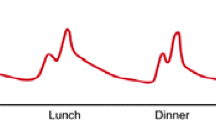Abstract
Plasma glucose control in the neonates and infants with diabetes based on dietary and multiple daily insulin injections is highly difficult. In this study, the infants were fed at 3- to 4-h intervals. All patients were started on insulin therapy with 0.6 U/kg/day divided equally into four doses. The morning, noon, and evening doses were given as premixed insulin (25% insulin lispro and 75% insulin lispro protamin sulphate), while the night insulin dose was given as premixed or neutral protamin Hagedorn (NPH) insulin according to the feeding frequency during the night. Nine-point capillary blood glucose profiles, HbA1c, and anthropometric measurements were evaluated. The study had 15 infants diagnosed with neonatal diabetes (ND) or type 1 diabetes mellitus (T1DM). The mean duration of the follow-up was 22.9 ± 8.7 months. During the follow-up, all patients had experienced sufficient weight and length gains and had experienced neither any episode of ketoacidosis nor wide fluctuations in blood glucose levels. Hypoglycemia, normoglycemia, and hyperglycemia were reported in 9.1, 79.9, and 11% of all the blood glucose measurements, respectively. Severe hypoglycemia was not experienced by any patients. The mean HbA1c levels in the patients with ND and T1DM at the last visit were 7.0 ± 0.2 and 7.6 ± 0.56%, respectively. The findings suggest that our approach is useable for plasma glucose control without wide fluctuations in infants with diabetes.


Similar content being viewed by others
References
Shield JP. Neonatal diabetes. Horm Res. 2007;68(Suppl 5):32–36.
Slingerland AS, Shields BM, Flanagan SE, et al. Referral rates for diagnostic testing support an incidence of permanent neonatal diabetes in three European countries of at least 1 in 260,000 live births. Diabetologia. 2009;52(8):1683–5.
Rubio-Cabezas O, Flanagan SE, Damhuis A, Hattersley AT, Ellard S. KATP channel mutations in infants with permanent diabetes diagnosed after 6 months of life. Pediatr Diabetes. 2012;13(4):322–5.
Rubio-Cabezas O, Ellard S. Diabetes mellitus in neonates and infants: genetic heterogeneity, clinical approach to diagnosis, and therapeutic options. Horm Res Paediatr. 2013;80(3):137–46.
Iafusco D, Stazi MA, Cotichini R, et al. Permanent diabetes mellitus in the first year of life. Diabetologia. 2002;45(6):798–804.
Edghill EL, Dix RJ, Flanagan SE, et al. HLA genotyping supports a nonautoimmune etiology in patients diagnosed with diabetes under the age of 6 months. Diabetes. 2006;55(6):1895–8.
De León DD, Stanley CA. Permanent neonatal diabetes mellitus. In: Pagon RA, Adam MP, Ardinger HH, Bird TD, Dolan CR, Fong CT, Smith RJH, Stephens K, editors. GeneReviews® [Internet]. Seattle: University of Washington; 2008. p. 1993–2014.
World Medical Association. World Medical Association Declaration of Helsinki. Ethical principles for medical research involving human subjects. Nurs Ethics. 2002;9:105–9.
International Conference on Harmonisation. ICH Harmonised Tripartite Guideline. Good clinical practice. 1996 01–May.
World Health Organization. Global strategy for infant and young child feeding. Geneva: WHO; 2003.
World Health Organization, WHO. Feeding and nutrition of infants and young children: guidelines for the WHO European region. Geneva: WHO; 2000.
Rearson MA, Mcknight-Menci H, Steinkrauss L. Neonatal diabetes: current trends in diagnosis and management. MCN Am J Matern Child Nurs. 2011;36(1):17–22.
Tubiana-Rufi N. Insulin pump therapy in neonatal diabetes. Endocr Dev. 2007;12:67–74.
Varadarajan P. Infantile onset diabetes mellitus in developing countries—India. World J Diabetes. 2016;7(6):134–41.
Beardsall K, Pesterfield CL, Acerini CL. Neonatal diabetes and insulin pump therapy. Arch Dis Child Fetal Neonatal Ed. 2011;96(3):F223–4.
Doneray H, Houghton J, Tekgunduz KS, Balkir F, Caner I. Permanent neonatal diabetes mellitus caused by a novel mutation in the KCNJ11 gene. J Pediatr Endocrinol Metab. 2014;27(3–4):367–71.
Rosenbauer J, Herzig P, Von Kries R, Neu A, Giani G. Temporal, seasonal, and geographical incidence patterns of type I diabetes mellitus in children under 5 years of age in Germany. Diabetologia. 1999;42(9):1055–9.
Grulich-Henn J, Wagner V, Thon A, et al. Entities and frequency of neonatal diabetes: data from the diabetes documentation and quality management system (DPV). Diabet Med. 2010;27(6):709–12.
Acknowledgements
The authors are grateful to Andrew Hattersley and Sian Ellard (Peninsula Medical School, Molecular Genetics Royal Devon & Exeter NHS Hospital, Exeter, United Kingdom), Jukka Kallijarvi (Folkhälsan Research Center, University of Helsinki, Helsinki, Finland), and Roger Colobran (Hospital University Vall d’Hebron, Barcelona, Spain) for the molecular genetic tests in cases 1–5. All genetic tests were done free of charge. They also thank Ayhan Tastekin (Faculty of Medicine, Istanbul Medipol University, Istanbul, Turkey) for the cooperation and participation in case 5.
Author information
Authors and Affiliations
Corresponding author
Ethics declarations
The study was approved by the Ataturk University of Medical Sciences ethics committee. Written informed consent form was signed by parents.
Conflict of interest
The authors declare that they have no conflicts of interest.
Rights and permissions
About this article
Cite this article
Doneray, H., Ozden, A. & Yesilcibik, R.S. A standardized approach based on dietary and multiple daily insulin injections for the management of diabetes in infants. Int J Diabetes Dev Ctries 38, 345–352 (2018). https://doi.org/10.1007/s13410-017-0590-1
Received:
Accepted:
Published:
Issue Date:
DOI: https://doi.org/10.1007/s13410-017-0590-1




